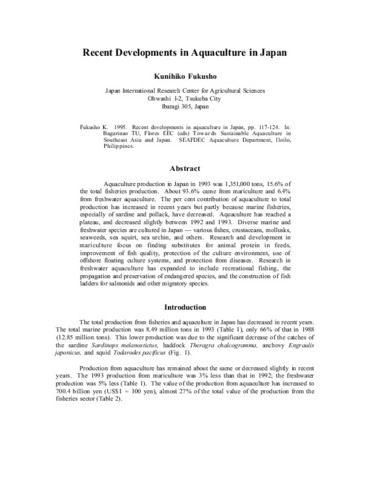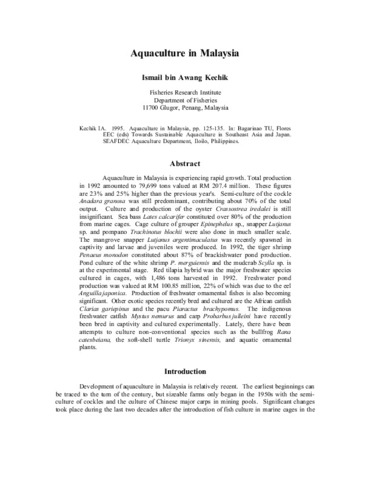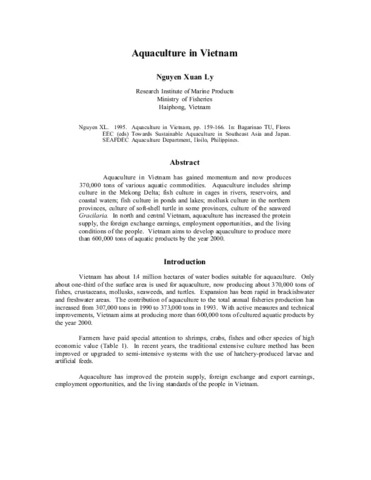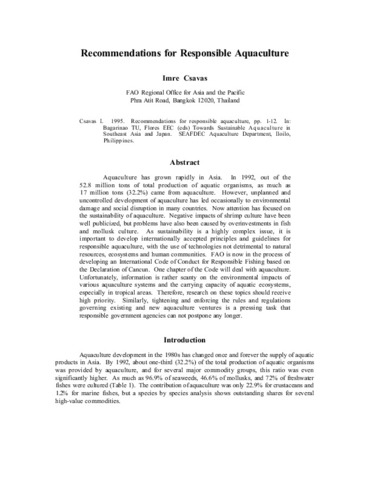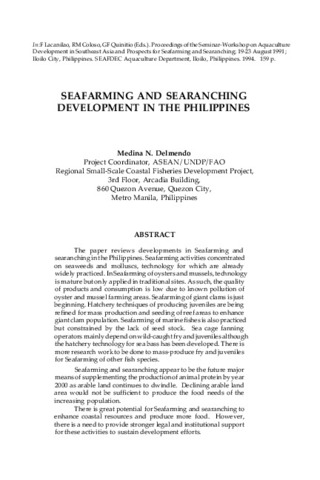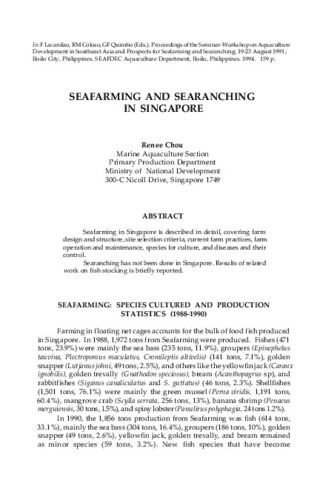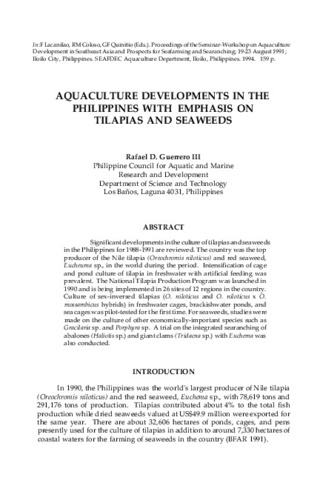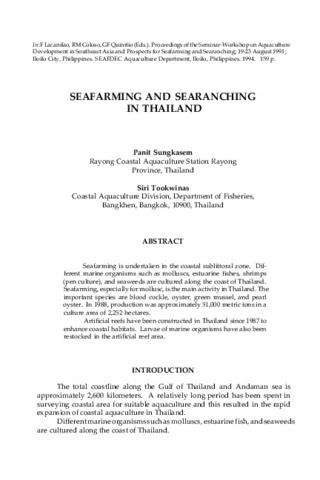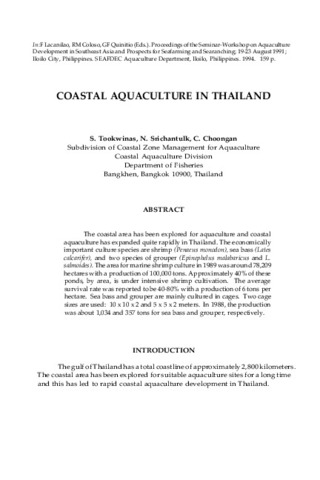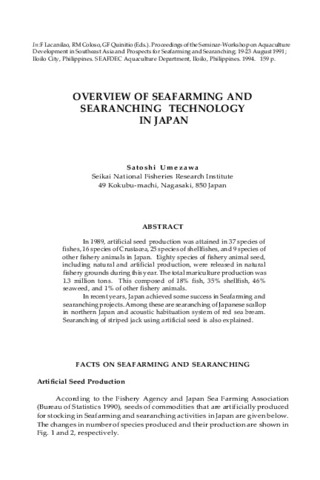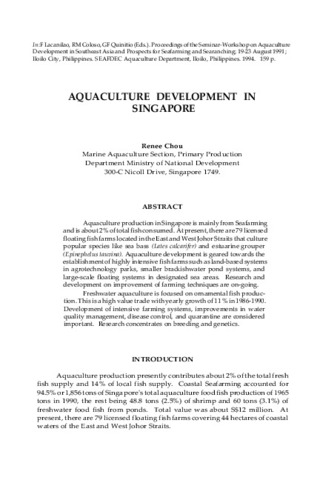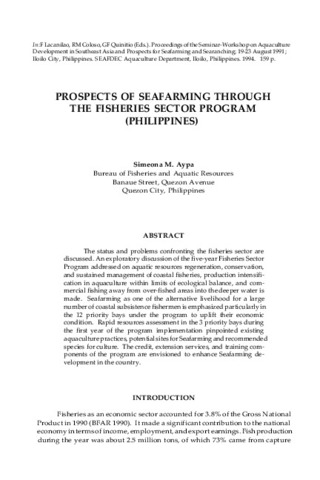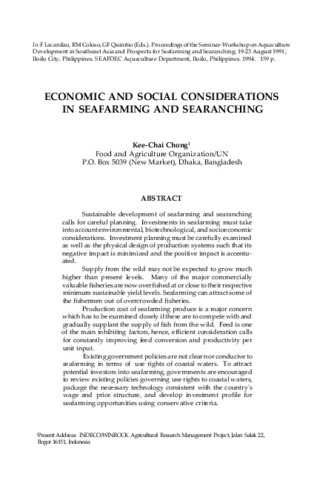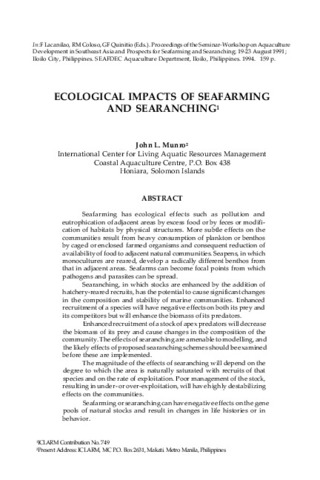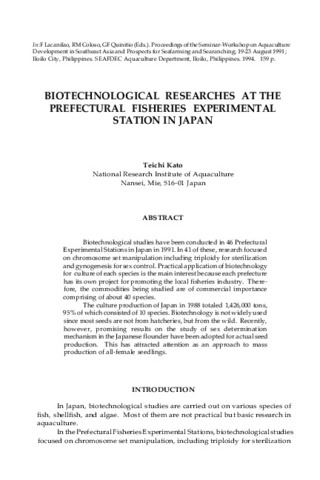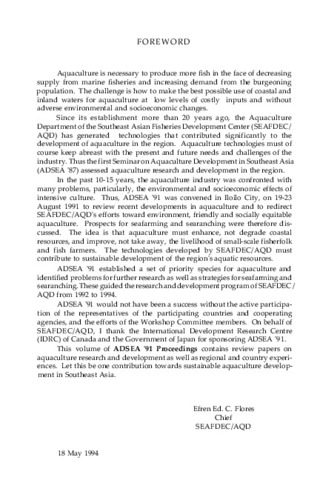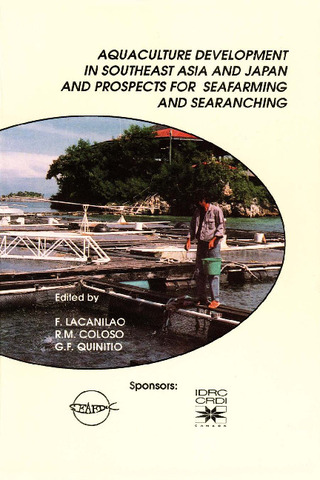Conference Proceedings: Recent submissions
Now showing items 741-760 of 767
-
Coastal aquaculture in Thailand
(Aquaculture Department, Southeast Asian Fisheries Development Center, 1995)Coastal aquaculture in Thailand has expanded rapidly in both area and production in the last decade. The important cultured species are the shrimps (Penaeus monodon and P. merguiensis), sea bass Lates calcarifer, groupers ... -
Recent developments in aquaculture in Japan
(Aquaculture Department, Southeast Asian Fisheries Development Center, 1995)Aquaculture production in Japan in 1993 was 1,351,000 tons, 15.6% of the total fisheries production. About 93.6% came from mariculture and 6.4% from freshwater aquaculture. The per cent contribution of aquaculture to total ... -
Aquaculture in the Philippines
(Aquaculture Department, Southeast Asian Fisheries Development Center, 1995)Aquaculture is regarded as the most promising source of protein food in the years ahead. Milkfish and Nile tilapia are the major fishes now produced but groupers, sea bass, rabbitfish, red snappers, carps, and catfishes ... -
Aquaculture in Malaysia
(Aquaculture Department, Southeast Asian Fisheries Development Center, 1995)Aquaculture in Malaysia is experiencing rapid growth. Total production in 1992 amounted to 79,699 tons valued at RM 207.4 million. These figures are 23% and 25% higher than the previous year's. Semi-culture of the cockle ... -
Aquaculture in Vietnam
(Aquaculture Department, Southeast Asian Fisheries Development Center, 1995)Aquaculture in Vietnam has gained momentum and now produces 370,000 tons of various aquatic commodities. Aquaculture includes shrimp culture in the Mekong Delta; fish culture in cages in rivers, reservoirs, and coastal ... -
Recommendations for responsible aquaculture
(Aquaculture Department, Southeast Asian Fisheries Development Center, 1995)Aquaculture has grown rapidly in Asia. In 1992, out of the 52.8 million tons of total production of aquatic organisms, as much as 17 million tons (32.2%) came from aquaculture. However, unplanned and uncontrolled development ... -
Seafarming and searanching development in the Philippines
(Aquaculture Department, Southeast Asian Fisheries Development Center, 1994)The paper reviews developments in Seafarming and searanching in the Philippines. Seafarming activities concentrated on seaweeds and molluscs, technology for which are already widely practiced. In Seafarming of oysters and ... -
Seafarming and searanching in Singapore
(Aquaculture Department, Southeast Asian Fisheries Development Center, 1994)Seafarming in Singapore is described in detail, covering farm design and structure, site selection criteria, current farm practices, farm operation and maintenance, species for culture, and diseases and their control.Searanching ... -
Aquaculture developments in the Philippines with emphasis on tilapias and seaweeds
(Aquaculture Department, Southeast Asian Fisheries Development Center, 1994)Significant developments in the culture of tilapias and seaweeds in the Philippines for 1988-1991 are reviewed. The country was the top producer of the Nile tilapia (Oreochromis niloticus) and red seaweed, Eucheuma sp., ... -
Seafarming and searanching in Thailand
(Aquaculture Department, Southeast Asian Fisheries Development Center, 1994)Seafarming is undertaken in the coastal sublittoral zone. Different marine organisms such as molluscs, estuarine fishes, shrimps (pen culture), and seaweeds are cultured along the coast of Thailand. Seafarming, especially ... -
Coastal aquaculture in Thailand
(Aquaculture Department, Southeast Asian Fisheries Development Center, 1994)The coastal area has been explored for aquaculture and coastal aquaculture has expanded quite rapidly in Thailand. The economically important culture species are shrimp (Penaeus monodon), sea bass (Lates calcarifer), and ... -
Overview of seafarming and searanching technology in Japan
(Aquaculture Department, Southeast Asian Fisheries Development Center, 1994)In 1989, artificial seed production was attained in 37 species of fishes, 16 species of Crustacea, 25 species of shellfishes, and 9 species of other fishery animals in Japan. Eighty species of fishery animal seed, including ... -
Aquaculture development in Singapore
(Aquaculture Department, Southeast Asian Fisheries Development Center, 1994)Aquaculture production in Singapore is mainly from Seafarming and is about 2% of total fish consumed. At present, there are 79 licensed floating fish farms located in the East and West Johor Straits that culture popular ... -
Prospects of seafarming through the Fisheries Sector Program (Philippines)
(Aquaculture Department, Southeast Asian Fisheries Development Center, 1994)The status and problems confronting the fisheries sector are discussed. An exploratory discussion of the five-year Fisheries Sector Program addressed on aquatic resources regeneration, conservation, and sustained management ... -
Economic and social considerations in seafarming and searanching
(Aquaculture Department, Southeast Asian Fisheries Development Center, 1994)Sustainable development of seafarming and searanching calls for careful planning. Investments in seafarming must take into account environmental, biotechnological, and socioeconomic considerations. Investment planning must ... -
Ecological impacts of seafarming and searanching
(Aquaculture Department, Southeast Asian Fisheries Development Center, 1994)Seafarming has ecological effects such as pollution and eutrophication of adjacent areas by excess food or by feces or modification of habitats by physical structures. More subtle effects on the communities result from ... -
Biotechnological researches at the Prefectural Fisheries Experimental Station in Japan
(Aquaculture Department, Southeast Asian Fisheries Development Center, 1994)Biotechnological studies have been conducted in 46 Prefectural Experimental Stations in Japan in 1991. In 41 of these, research focused on chromosome set manipulation including triploidy for sterilization and gynogenesis ... -
Overview of aquaculture development in Southeast Asia
(Aquaculture Department, Southeast Asian Fisheries Development Center, 1994)The nine countries in Southeast Asia occupy a land area of 1.85% with a population of 7.4% in the world. In 1991, these countries had a total fisheries production of 10.2 million tons or 10.5% of the world total of 96.9 ... -
ADSEA '91-Foreword
(Aquaculture Department, Southeast Asian Fisheries Development Center, 1994) -
ADSEA '91-Preliminary pages
(Aquaculture Department, Southeast Asian Fisheries Development Center, 1994)Cover page, title page and table of contents


